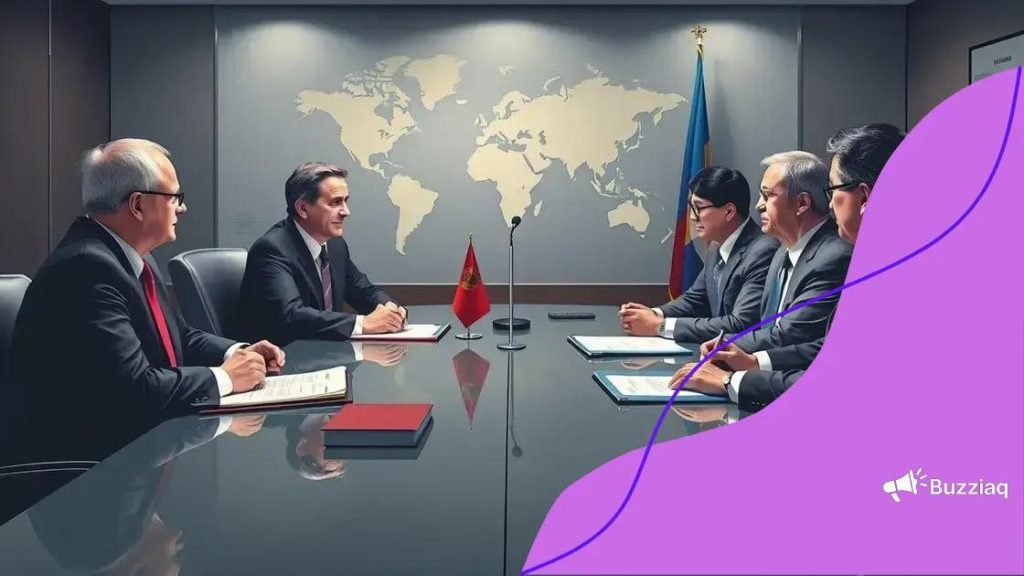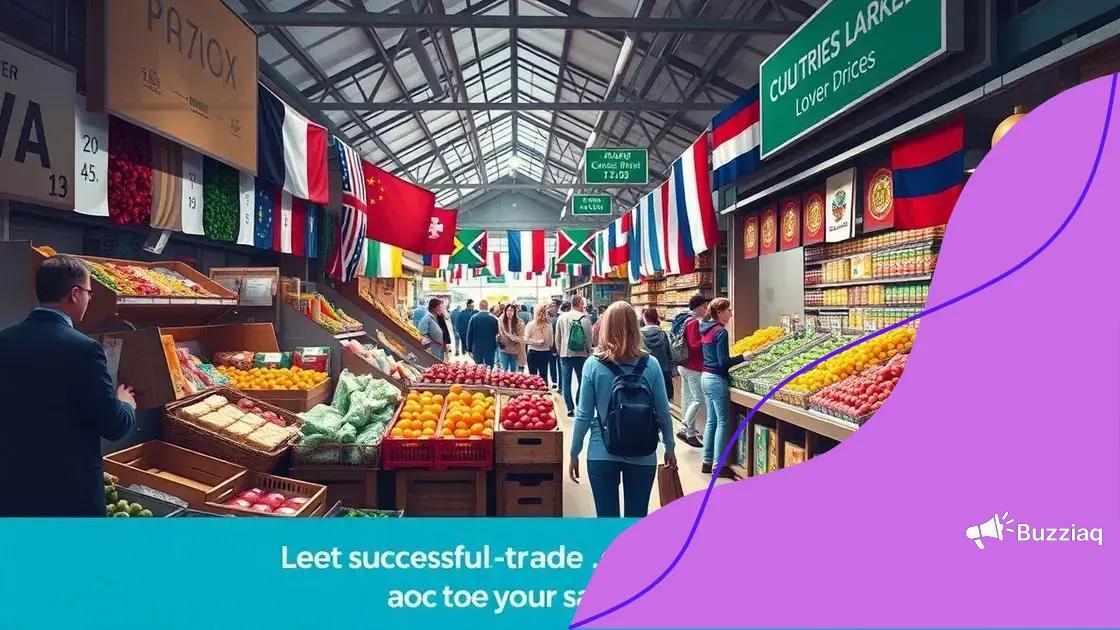Trade agreement negotiations: what you need to know

AD
Trade agreement negotiations are essential processes where countries establish rules for trading goods and services, focusing on reducing tariffs, enhancing market access, and addressing the interests of various stakeholders.
Trade agreement negotiations play a crucial role in shaping global economies and connecting markets. Have you ever wondered how these deals influence your everyday life? Let’s dive into their complexities and uncover their importance.
AD
Understanding trade agreement negotiations
Understanding trade agreement negotiations is essential for businesses and governments alike. These negotiations shape how countries engage in trade and what conditions govern these exchanges. Whether you are a business owner or a consumer, learning about these agreements can help you see the bigger picture in global commerce.
What are Trade Agreements?
Trade agreements are contracts between two or more countries that outline the rules for trading goods and services. They can also cover issues like tariffs, import quotas, and investment. By establishing these regulations, countries aim to boost their economies and provide benefits to their citizens.
Why Are Negotiations Important?
Negotiations are vital because they determine the terms of these agreements. A successful negotiation can lead to lower prices for consumers and more options for businesses. Conversely, poor negotiations may hurt economic relations and lead to trade barriers.
AD
Key Elements of Negotiations
- Participants’ objectives: Each party has specific goals they want to achieve.
- Tariff reductions: Negotiators strive to lower or eliminate tariffs.
- Dispute resolution mechanisms: Agreements often include clauses for addressing conflicts.
- Market access: Ensuring fair access to markets for all parties involved.
The process typically involves extensive discussions, where each party presents their needs. It’s crucial for negotiators to prepare thoroughly, understanding both sides’ priorities. This preparation enables them to strike a balance that benefits everyone.
The Role of Stakeholders
In trade negotiations, various stakeholders play significant roles. Government representatives often lead the talks, but they must also consider input from businesses, labor organizations, and the general public. Each of these groups has unique perspectives on what the outcomes should be. For instance, businesses may seek more favorable tax conditions, while workers might prioritize labor rights and standards.
Staying informed about these negotiations allows consumers to understand how changes in policies may affect their lives. For example, a new trade agreement could mean lower prices for imported goods or more options for services. When consumers are aware, they can better advocate for their needs during these discussions.
In summary, grasping the complexities of trade agreement negotiations empowers individuals and businesses to navigate the implications of these agreements effectively. Understanding the fundamental concepts, key elements, and stakeholder roles can make a difference in how one engages with the outcomes.
Key players in trade negotiations
In trade negotiations, understanding the key players involved is critical. These parties hold significant influence over the outcomes aimed at shaping trade laws and regulations. Knowing who they are helps clarify how agreements come to fruition.
Government Representatives
At the forefront of trade negotiations are government representatives, often including ministers and ambassadors. They represent their country’s interests and work to secure favorable terms. Their experience and knowledge of international policies heavily influence the discussions.
Business Leaders
Another important group includes business leaders from various sectors. They often provide insights on how trade agreements will impact their industries. Their input can lead to stronger deals that benefit the economy. For instance, manufacturers may advocate for lower tariffs to reduce costs.
Non-Governmental Organizations (NGOs)
NGOs and advocacy groups also play a vital role in these negotiations. They represent different causes, such as labor rights or environmental protection. Their perspectives can pressure governments to incorporate social and environmental standards into agreements.
Public Opinion
The voice of the public cannot be overlooked. As citizens express their views on trade policies, they influence government decisions. Public opinion can shape the agenda, leading negotiators to consider the desires and concerns of the electorate. Engaging with the community and ensuring transparency can build trust and support.
Successful negotiations often depend on the collaboration of these various groups. Each player brings unique insights, which can lead to comprehensive and effective agreements. When governments, businesses, NGOs, and the public work together, the resulting trade agreements are more likely to address multiple facets of economic and social needs.
Benefits of successful trade agreements

Successful trade agreements can bring numerous benefits to participating countries. Understanding these advantages helps underline the importance of negotiation processes. These benefits often extend beyond economics, influencing social and political landscapes.
Economic Growth
One of the most significant benefits of successful trade agreements is economic growth. By reducing tariffs and barriers to trade, countries can trade more freely. This freedom allows businesses to expand their markets and find new customers, leading to increased sales and profits.
Job Creation
Trade agreements also contribute to job creation. As companies grow, they often need to hire more workers. Jobs may be created in export sectors, where businesses can afford to expand due to lower costs from trade agreements. Not only are new jobs created, but existing jobs can also become more secure as businesses strengthen their global presence.
Lower Prices for Consumers
Successful negotiations can result in lower prices for consumers. When tariffs are reduced, products can be imported at a lower cost. This decrease often means that businesses can offer more competitive prices to customers. Lower prices enhance consumer spending power, allowing families to purchase more goods and services.
- Access to a wider variety of goods.
- Increased competition, leading to better quality.
- Improved supply chain efficiency.
Moreover, trade agreements can lead to stronger diplomatic relations. By forging trade partnerships, countries can build trust and cooperation. This collaboration can help stabilize regions and encourage peaceful relations.
In addition to economic and diplomatic benefits, these agreements can also promote environmental and labor standards. Many modern trade deals include provisions that ensure fair labor practices and environmental protections. This commitment to high standards can help improve conditions globally.
Challenges faced in negotiations
Challenges faced in trade negotiations can vary widely, impacting the success of reaching agreements. Understanding these obstacles is crucial for negotiators and stakeholders involved in the process. Some common challenges can impede progress and create tensions between negotiating parties.
Differences in National Interests
One significant challenge is navigating the differences in national interests. Each country has unique priorities, which can lead to conflicts during negotiations. For instance, one nation may focus on lowering tariffs, while another may prioritize protecting its domestic industries. Finding a balance that satisfies all parties can be extremely difficult.
Complexity of Trade Issues
The complexity of trade issues adds another layer of difficulty. Negotiations often cover many topics, from tariffs and quotas to labor standards and environmental policies. This complexity requires thorough knowledge and preparation on all sides. Misunderstandings can arise if parties are not adequately informed, leading to delays and frustration.
Political Pressures
Political pressures can also influence negotiations significantly. Domestic groups may lobby against certain agreements, creating obstacles for negotiators. For example, labor unions may oppose trade deals they believe threaten jobs. Negotiators must address these pressures while striving to complete agreements.
- Balancing short-term and long-term benefits.
- Responding to public opinion and media scrutiny.
- Maintaining transparency throughout the process.
The role of timing cannot be overlooked. External events, such as elections or economic crises, can shift priorities and complicate discussions. Trade negotiators must remain adaptable to these changes while seeking favorable outcomes.
Additionally, achieving consensus among multiple stakeholders can prove challenging. Diverse interests mean that building coalitions and alliances may take considerable time and effort. Each participant may have specific demands that need to be navigated delicately.
Future trends in trade agreements
Future trends in trade agreements are likely to be influenced by several factors, including technological advancements and changing global dynamics. Recognizing these trends can help businesses and policymakers prepare for what lies ahead.
Increased Digital Trade
One major trend is the rise of digital trade. As more commerce moves online, agreements will start to address issues related to e-commerce, data privacy, and cybersecurity. Negotiators will likely focus on creating rules that facilitate cross-border data flow while ensuring protection of personal information.
Focus on Sustainability
Another important trend is the growing emphasis on sustainability in trade agreements. Countries are beginning to recognize the need for incorporating environmental standards. This focus on sustainability can drive regulations that promote green practices and combat climate change. For example, trade deals may include provisions for reducing carbon emissions or protecting biodiversity.
- Promotion of renewable energy technologies.
- Support for sustainable agriculture practices.
- Incentives for businesses adopting eco-friendly policies.
As global awareness of climate issues increases, more countries may demand that trade agreements reflect these priorities. Stakeholders will need to work together to develop solutions that balance economic growth with environmental protection.
Greater Inclusivity
Expect to see a trend toward greater inclusivity as well. This means recognizing the interests of various groups, including labor organizations and small businesses. Inclusive negotiations can ensure that trade agreements benefit a broader range of stakeholders, not just large corporations. Such collaborations will allow various voices to be heard, pushing for fairer terms.
Moreover, advancements in communication technology can facilitate these discussions. Additionally, the involvement of civil society can lead to increased transparency in negotiations. As public scrutiny grows, negotiators may prioritize clear communication of the benefits and risks associated with trade policies.
In summary, watching for these future trends in trade agreements can help businesses and governments navigate the evolving landscape of global trade better. By staying informed, stakeholders can adapt strategies that align with upcoming changes.
FAQ – Frequently Asked Questions about Trade Agreement Negotiations
What are trade agreements?
Trade agreements are contracts between countries that outline the rules for trading goods and services, including tariffs and market access.
Why are trade negotiations important?
Trade negotiations help determine the terms of agreements that can lead to lower prices for consumers and job creation in various sectors.
What challenges do negotiators face?
Negotiators face challenges such as differing national interests, political pressures, and the complexity of trade issues.
What trends should we expect in future trade agreements?
Future trade agreements are expected to focus on digital trade, sustainability, and inclusivity, reflecting global changes and priorities.